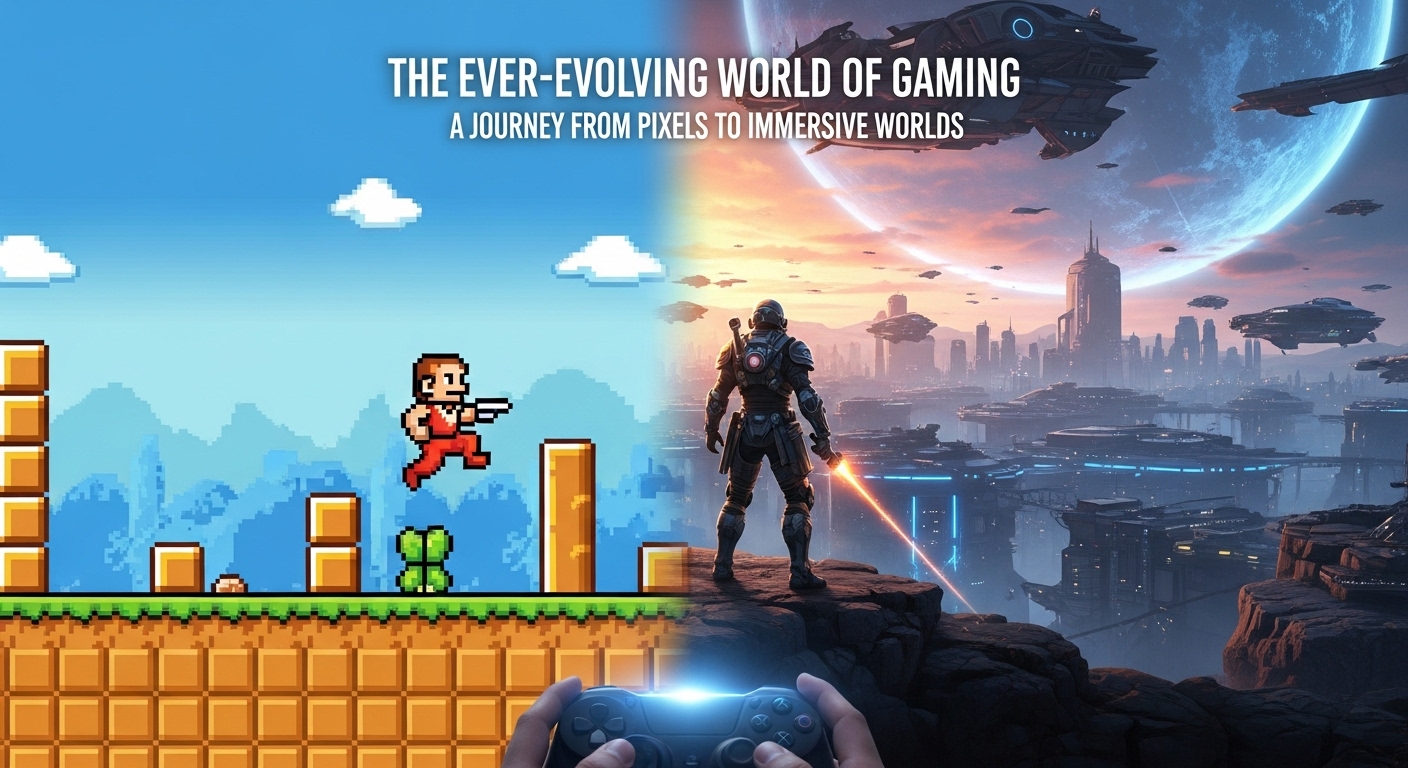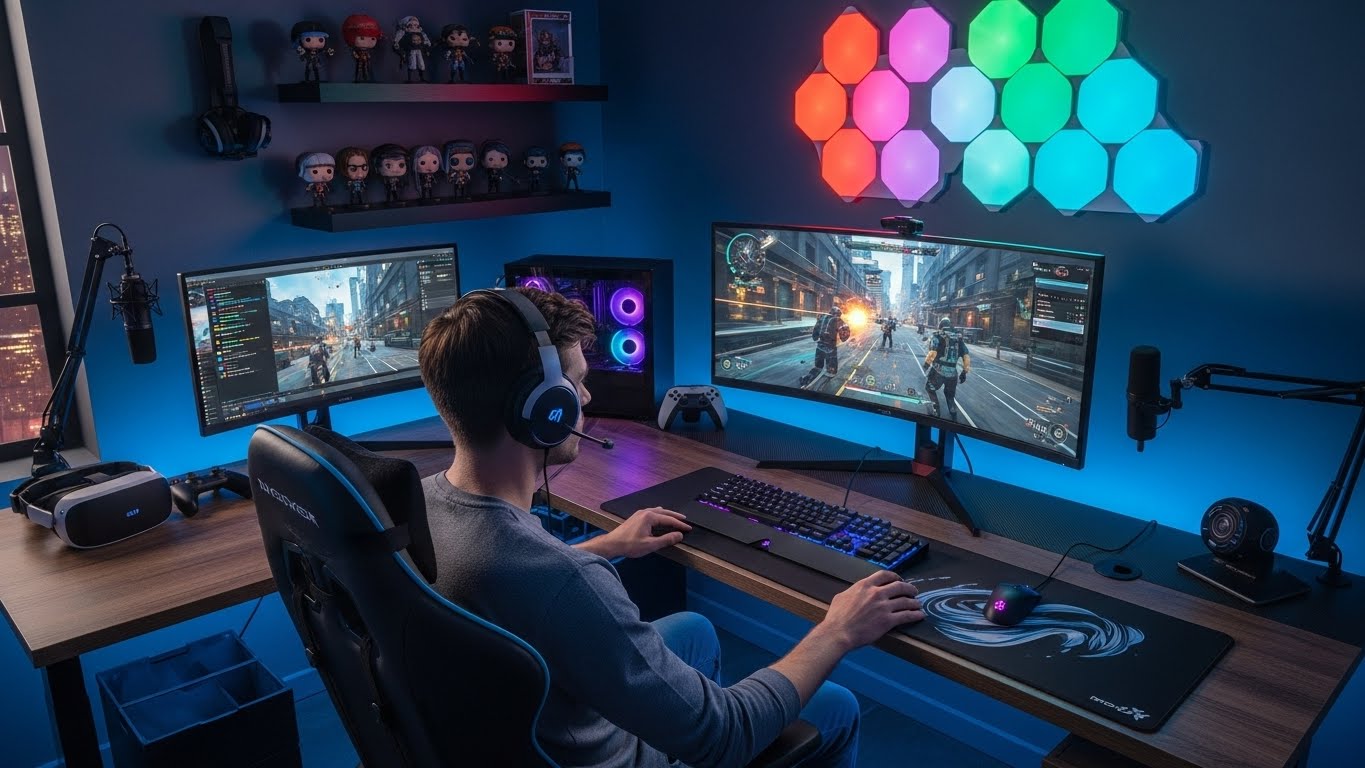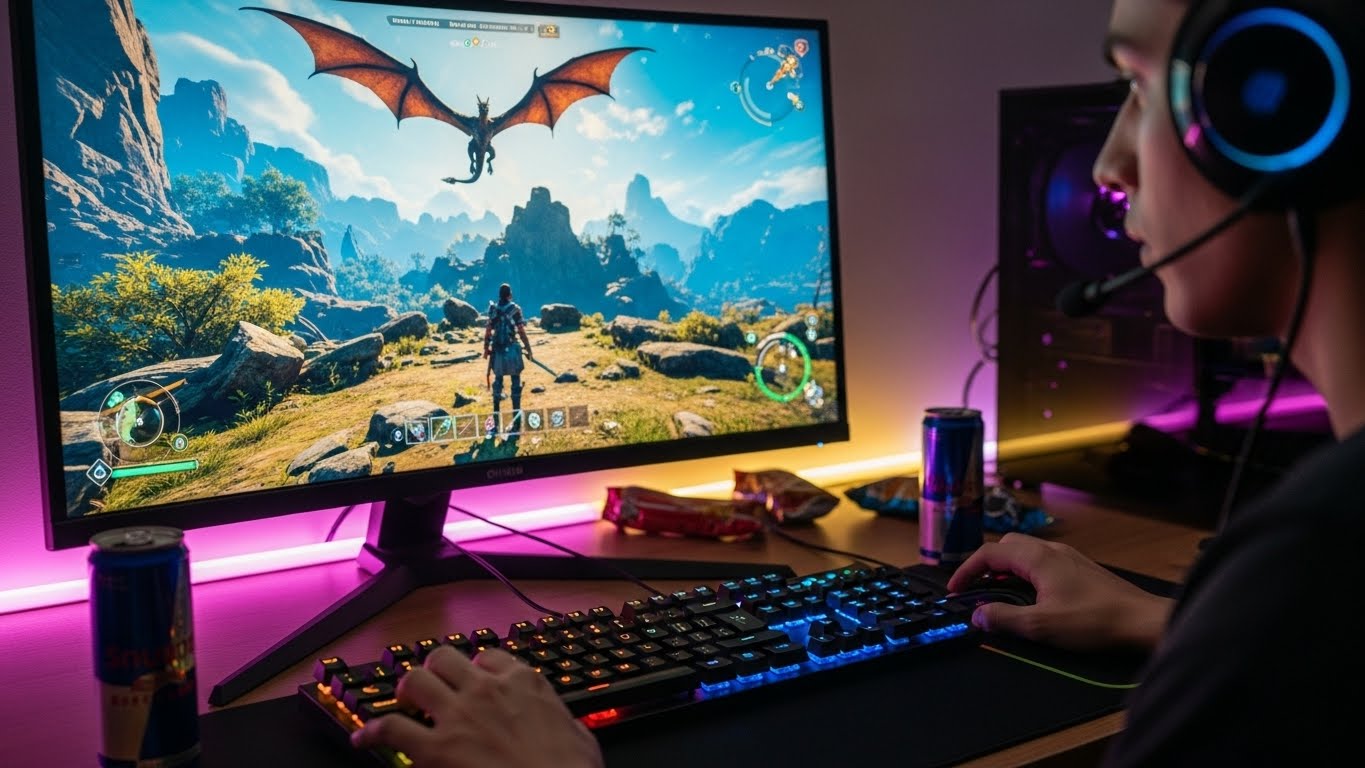Gaming has become one of the most powerful cultural forces of the modern era. What began as a small experiment with pixels and sounds has grown into a global industry worth hundreds of billions of dollars. Beyond the numbers, gaming is now a language of creativity, competition, storytelling, and connection. It touches nearly every aspect of life—from entertainment and education to technology and even social change. The journey of gaming is not just about consoles and computers; it’s about imagination, human interaction, and the desire to explore worlds beyond our own.
The Early Days: When Gaming Was an Experiment
In the 1950s and 60s, computers were massive machines that filled entire rooms, built not for fun but for calculations and scientific research. Yet, a few curious engineers and students found ways to turn logic circuits into playthings. One of the earliest known games, “Tennis for Two,” appeared on an oscilloscope in 1958. It was simple—just two paddles and a bouncing dot—but it planted the seed of something extraordinary.
By the 1970s, that spark had grown. Games like “Pong,” “Space Invaders,” and “Pac-Man” became household names. The arcade era had begun. These machines gathered people in small dark rooms filled with flashing lights and coins clinking against metal. Players weren’t just looking at screens; they were competing for high scores, for recognition, and for the simple thrill of mastering a game.
The appeal was immediate and universal. Gaming in those early years represented innovation, challenge, and accessibility. You didn’t need to be an athlete or an artist—you just needed a few coins and quick reflexes.
The Rise of Home Consoles
When the first home gaming consoles appeared, they changed everything. No longer did you have to visit an arcade to play your favorite titles. With systems like the Atari 2600 and the Nintendo Entertainment System, gaming came to the living room. Parents complained about children spending too much time in front of the TV, while children marveled at the idea that they could control what appeared on the screen.
The 1980s were a golden decade for gaming’s creativity. Developers experimented with side-scrolling adventures, puzzle-solving mechanics, and more complex storytelling. “Super Mario Bros.” became a cultural phenomenon, defining the platforming genre and showing that games could have personality and character. “The Legend of Zelda” introduced the concept of exploration and discovery within digital worlds. For the first time, games had a sense of place and purpose beyond points and scores.
Gaming was no longer a novelty—it was becoming a legitimate form of entertainment.
The 1990s: Technology Meets Imagination
The 1990s marked a huge leap forward. Graphics moved from 2D sprites to 3D polygons. The emergence of consoles like the PlayStation, Nintendo 64, and Sega Dreamcast changed the landscape of what was possible. Suddenly, characters could move in all directions, and worlds became larger, deeper, and more realistic.
This was also the decade that gave birth to gaming franchises that still dominate today. Titles like “Final Fantasy VII,” “Metal Gear Solid,” and “Resident Evil” demonstrated that games could tell cinematic stories filled with emotion and complexity. The combination of music, visuals, and interactive storytelling drew players in like never before.
Meanwhile, PC gaming was growing in its own direction. The rise of real-time strategy games like “StarCraft” and first-person shooters like “DOOM” and “Half-Life” redefined genres. Online multiplayer experiences began to take shape, laying the foundation for what would eventually become esports.
Gaming was evolving faster than anyone could have predicted. The boundaries between player and storyteller, between developer and fan, were starting to blur.
The Birth of Online Gaming and Community
As the internet became more accessible, gaming entered its next revolution: online play. Suddenly, games weren’t just solo experiences or local competitions. You could connect with people from across the world, cooperate, compete, and share moments of joy and frustration in real time.
Massively multiplayer online games like “World of Warcraft” became cultural phenomena. Entire virtual societies emerged, complete with economies, guilds, and friendships that transcended physical boundaries. Players could explore worlds that never slept, where adventure waited at any hour.
Online gaming also gave rise to a new kind of social interaction. Voice chat, message boards, and streaming began to connect players in ways that traditional media never could. The gaming community wasn’t confined to consoles or computers—it existed everywhere, growing across continents, languages, and cultures.
However, with this growth came challenges. Issues like toxicity, addiction, and online harassment became topics of discussion. Yet, through it all, gaming communities continued to innovate, creating spaces for creativity, collaboration, and self-expression.
The Rise of Esports: From Hobby to Global Stage
At one time, the idea of watching someone else play a video game might have seemed strange. Today, it’s an international phenomenon. Esports has turned gaming into a spectator sport rivaling traditional athletics in viewership and investment.
What began with small LAN tournaments has evolved into massive global competitions with prize pools in the millions. Games like “League of Legends,” “Counter-Strike,” “Dota 2,” and “Fortnite” have professional players, coaches, and teams sponsored by major corporations. Stadiums fill with fans cheering for their favorite teams, while millions more watch from home.
Esports has also changed perceptions of what it means to be a gamer. Players are no longer just hobbyists—they are athletes in their own right, dedicating countless hours to training, teamwork, and strategy. Their reflexes, decision-making, and communication skills rival those of professionals in any traditional sport.
Beyond competition, esports has also become a career path. From commentators and analysts to event organizers and content creators, the industry has opened doors for countless individuals passionate about gaming.
Storytelling and Art in Modern Games
As technology advanced, so did the capacity for storytelling. Today’s games can rival films and novels in emotional depth and narrative sophistication. Titles like “The Last of Us,” “Red Dead Redemption 2,” and “God of War” have proven that games can move players to tears, challenge their beliefs, and make them think deeply about morality and humanity.
Game design has become a form of art. Developers carefully craft visuals, soundscapes, and gameplay mechanics to evoke specific emotions. A great game doesn’t just entertain—it immerses you. It makes you feel part of its world. Every choice matters, every environment tells a story, and every moment feels alive.
Independent developers have also pushed the boundaries of creativity. Without the constraints of large budgets, indie studios and solo creators have brought us games that focus on emotion, atmosphere, and innovation. Titles like “Journey,” “Hollow Knight,” and “Celeste” show that even simple mechanics can carry profound meaning when combined with thoughtful design.
Gaming has matured into one of the most diverse storytelling mediums ever created. It can be funny, dark, poetic, or tragic—all within the same interactive space.
The Psychology of Gaming
Why do we play games? The answer is both simple and complex. At its core, gaming fulfills some of our most basic psychological needs. It offers challenge, mastery, social connection, and escape.
Players often describe the feeling of “flow”—a mental state where they’re fully immersed, losing track of time and space. This sense of focus and accomplishment can be deeply rewarding. Games provide a structured way to face challenges, fail safely, and grow stronger with each attempt.
Socially, gaming builds communities. Multiplayer games create bonds between people who might never meet in real life but share a sense of teamwork and achievement. In an increasingly digital world, these virtual connections can be just as meaningful as physical ones.
There’s also the emotional side of gaming. Games can provide comfort, nostalgia, and even healing. For many, they serve as a way to process emotions, reduce stress, or find a sense of purpose. The virtual worlds we explore often reflect the real struggles we face—and sometimes, overcoming challenges in a game helps us face challenges outside of it.
Gaming as a Cultural Movement
Gaming is more than entertainment—it’s a cultural language. It shapes art, music, film, and even fashion. Iconic characters like Mario, Lara Croft, and Master Chief have become global symbols, recognized far beyond gaming circles.
Conventions such as Comic-Con and E3 celebrate gaming culture on a massive scale. Cosplay, fan art, and online communities keep the spirit of games alive long after players have finished the story. Streaming platforms have made gamers into celebrities, influencers, and storytellers in their own right.
The fusion of gaming and popular culture has also blurred the lines between creator and audience. Players mod games, create custom levels, and share their creations with millions. Some of the most popular games today—like “Minecraft” and “Roblox”—are built entirely on user-generated content. In gaming, the player is not just a consumer but an active participant in shaping the experience.
The Role of Technology in Gaming’s Growth
Every leap in gaming history has been tied to technological innovation. The transition from 8-bit to 3D graphics, from cartridges to digital downloads, from wired controllers to virtual reality—all these advances have reshaped how we play and experience games.
Artificial intelligence now drives enemy behavior and adapts to player decisions. Motion capture technology allows actors to bring lifelike emotion to digital characters. Cloud gaming services are making high-end experiences accessible without expensive hardware, streaming complex worlds directly to your screen.
Virtual reality and augmented reality are expanding the definition of play itself. Players can step inside digital worlds, explore environments as if they were physically there, and interact with objects in three-dimensional space. The sense of presence these technologies provide could redefine storytelling and education alike.
Gaming has also been at the forefront of pushing hardware boundaries. Faster processors, improved graphics cards, and realistic physics simulations continue to push the limits of immersion.
Gaming and Society
The influence of gaming extends far beyond entertainment. It has become a tool for learning, therapy, and social change. Educational games help students engage with subjects like history, science, and mathematics in interactive ways. Simulation games are used for training in fields like medicine, aviation, and engineering.
In therapy, gaming has shown promise in treating anxiety, depression, and PTSD. Virtual reality environments can help patients face fears, while cooperative gaming can reduce feelings of isolation.
Gaming has also become a platform for expression and activism. Developers are using the medium to tell stories about mental health, climate change, and social justice. Games like “Life Is Strange” and “This War of Mine” challenge players to confront difficult ethical questions, proving that interactive art can inspire empathy and awareness.
At the same time, gaming faces ongoing discussions around inclusivity and representation. The push for more diverse characters, stories, and voices is reshaping the industry for the better. Gaming’s future will depend not only on technology but on the stories it chooses to tell and the people it chooses to include.
The Future of Gaming
Looking ahead, the future of gaming seems limitless. Artificial intelligence, virtual reality, and cloud computing are converging to create experiences that were once unimaginable. Imagine games that adapt dynamically to your emotions, or worlds that evolve based on collective player choices.
The boundaries between reality and the digital realm will continue to blur. Augmented reality could turn our physical environments into playgrounds for interactive storytelling. Meanwhile, blockchain and user-generated economies may transform how virtual assets are owned and traded.
But beyond technology, the future of gaming will depend on creativity, inclusivity, and accessibility. Developers are finding new ways to reach audiences of all ages, abilities, and backgrounds. The next generation of games will not just be about better graphics or faster processors—they’ll be about deeper meaning and more human connection.
Conclusion: The Power of Play
From its humble beginnings on laboratory computers to its current position as a dominant cultural force, gaming has come a long way. It has evolved from pixels to lifelike worlds, from isolated play to global community, from entertainment to art.
At its heart, gaming is about curiosity and imagination. It’s about the joy of discovery, the thrill of competition, and the comfort of connection. Whether it’s a child exploring their first digital adventure, an adult finding relaxation after a long day, or a professional gamer competing on the world stage, the essence remains the same—play brings people together.
Gaming is no longer just a pastime; it’s a reflection of who we are as a species—creative, social, and endlessly curious. It’s a window into our collective imagination and a glimpse of what the future of human expression might look like.
As long as there are players, there will be games. And as long as there are games, the story of play will continue to grow, evolve, and inspire.



